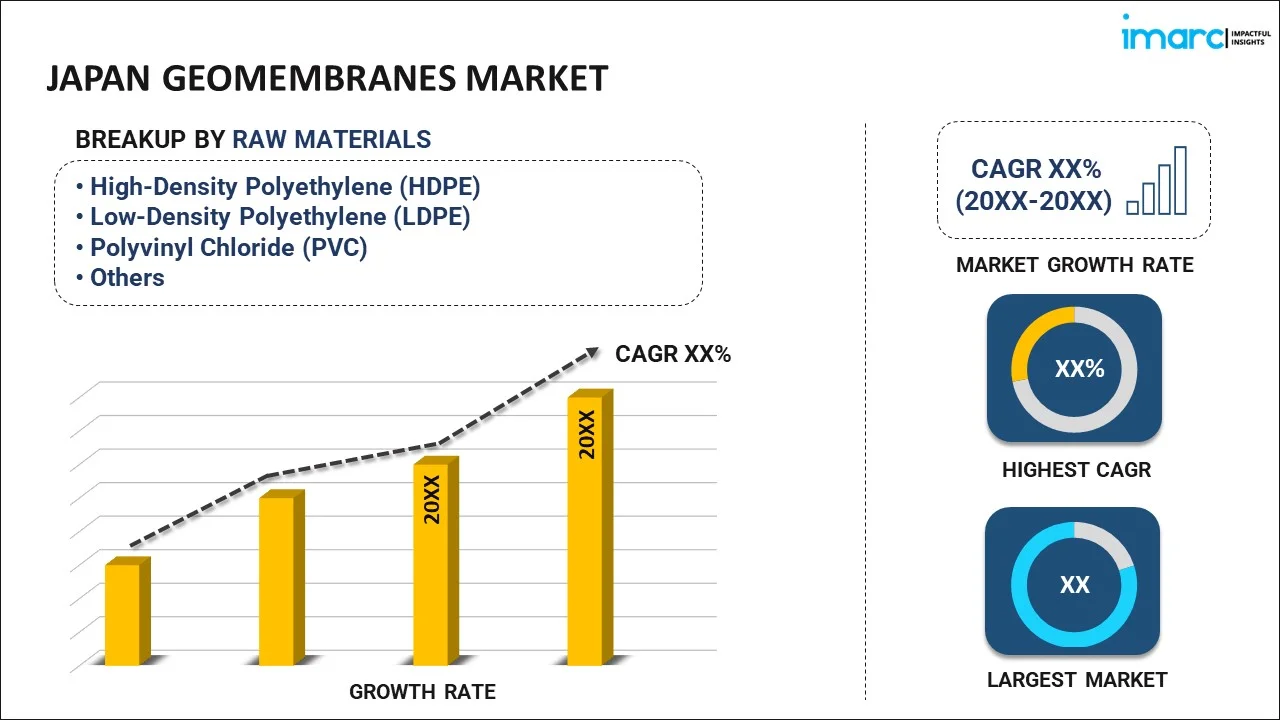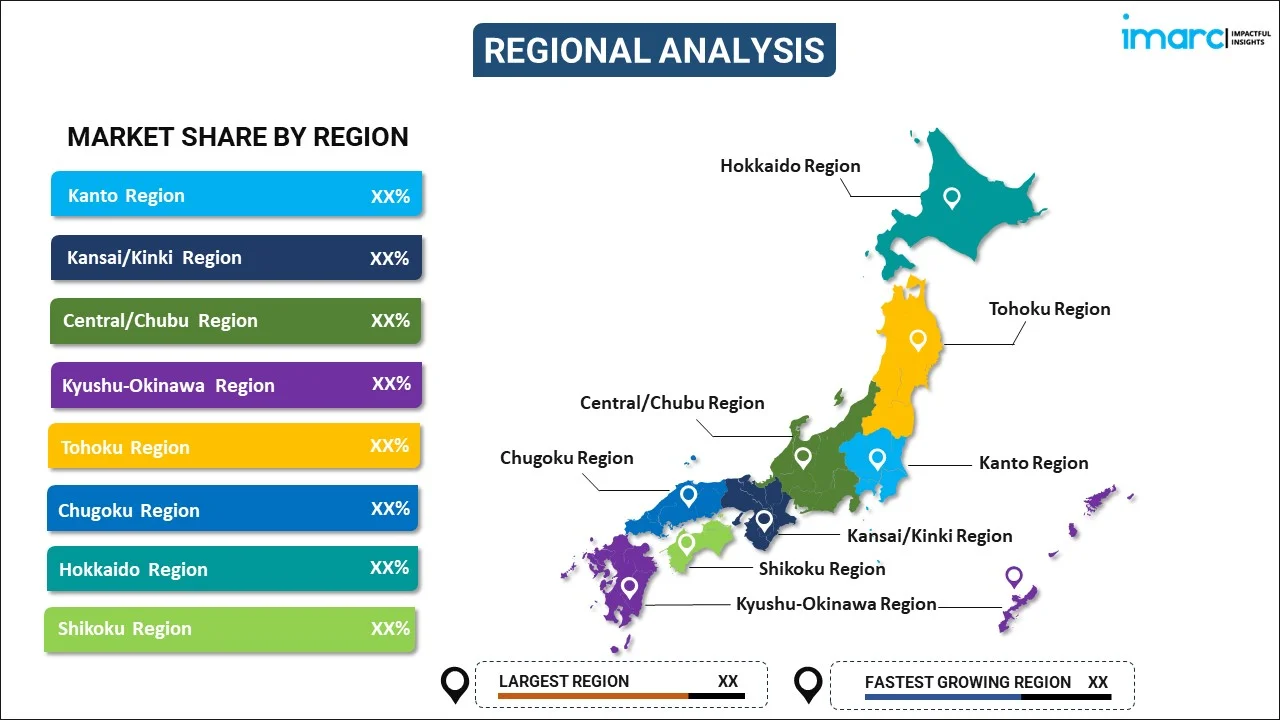
Japan Geomembranes Market Report by Raw Material (High-Density Polyethylene (HDPE), Low-Density Polyethylene (LDPE), Polyvinyl Chloride (PVC), Polypropylene (PP), and Others), Manufacturing Process (Blown Film, Calendering, and Others), Application (Mining, Waste Management, Water Management, and Others), and Region 2025-2033
Market Overview:
Japan geomembranes market size reached USD 85.8 Million in 2024. Looking forward, IMARC Group expects the market to reach USD 153.8 Million by 2033, exhibiting a growth rate (CAGR) of 6.1% during 2025-2033. The increasing prevalence of infrastructure development projects, including roads, highways, canals, and tunnels, which require geomembranes for waterproofing and preventing seepage in structures and foundations, is driving the market.
|
Report Attribute
|
Key Statistics
|
|---|---|
|
Base Year
|
2024 |
|
Forecast Years
|
2025-2033
|
|
Historical Years
|
2019-2024
|
| Market Size in 2024 | USD 85.8 Million |
| Market Forecast in 2033 | USD 153.8 Million |
| Market Growth Rate (2025-2033) | 6.1% |
Geomembranes are synthetic materials used in civil and environmental engineering for various containment applications. They are typically made of high-density polyethylene (HDPE), low-density polyethylene (LDPE), polyvinyl chloride (PVC), or other polymer materials. Geomembranes serve as impermeable barriers to prevent the leakage of liquids or gases in construction projects such as landfills, mining operations, water storage reservoirs, and wastewater treatment facilities. These flexible, durable sheets are chosen for their resistance to chemical and environmental degradation, as well as their ability to withstand harsh weather conditions. Geomembranes are installed by being laid over a prepared surface and are often combined with geotextiles to provide additional reinforcement and protection. They help mitigate environmental contamination risks by preventing the migration of pollutants into the soil and groundwater. The selection of an appropriate geomembrane material depends on factors like the specific application, site conditions, and regulatory requirements. Geomembranes play a crucial role in modern engineering and environmental protection, ensuring the safe containment of hazardous substances and the preservation of ecosystems.
Japan Geomembranes Market Trends:
The geomembranes market in Japan is experiencing robust growth due to a combination of factors. Firstly, the increasing awareness of environmental protection and sustainability is driving the adoption of geomembranes. These synthetic barriers play a pivotal role in preventing soil and water contamination, thereby mitigating the impact of industrial and agricultural activities on ecosystems. Additionally, stringent government regulations mandating the use of geomembranes in various applications such as landfill construction, mining, and wastewater management are propelling market growth. Furthermore, the expanding infrastructure development and urbanization in Japan are leading to greater demand for geomembranes in construction projects. These versatile materials provide impermeable barriers, enhancing the durability and lifespan of structures like reservoirs and tunnels. Moreover, the growing focus on water conservation and resource management is encouraging the use of geomembranes in water containment and irrigation systems, fostering market expansion. Additionally, advancements in geomembrane technology, such as the development of reinforced and textured geomembranes that can enhance their performance and versatility, are expected to drive the geomembranes market in Japan during the forecast period.
Japan Geomembranes Market Segmentation:
IMARC Group provides an analysis of the key trends in each segment of the market, along with forecasts at the country level for 2025-2033. Our report has categorized the market based on raw material, manufacturing process, and application.
Raw Material Insights:

- High-Density Polyethylene (HDPE)
- Low-Density Polyethylene (LDPE)
- Polyvinyl Chloride (PVC)
- Polypropylene (PP)
- Others
The report has provided a detailed breakup and analysis of the market based on the raw material. This includes high-density polyethylene (HDPE), low-density polyethylene (LDPE), polyvinyl chloride (PVC), polypropylene (PP), and others.
Manufacturing Process Insights:
- Blown Film
- Calendering
- Others
A detailed breakup and analysis of the market based on the manufacturing process have also been provided in the report. This includes blown film, calendering, and others.
Application Insights:
- Mining
- Waste Management
- Water Management
- Others
The report has provided a detailed breakup and analysis of the market based on the application. This includes mining, waste management, water management, and others.
Regional Insights:

- Kanto Region
- Kansai/Kinki Region
- Central/ Chubu Region
- Kyushu-Okinawa Region
- Tohoku Region
- Chugoku Region
- Hokkaido Region
- Shikoku Region
The report has also provided a comprehensive analysis of all the major regional markets, which include Kanto Region, Kansai/Kinki Region, Central/ Chubu Region, Kyushu-Okinawa Region, Tohoku Region, Chugoku Region, Hokkaido Region, and Shikoku Region.
Competitive Landscape:
The market research report has also provided a comprehensive analysis of the competitive landscape in the market. Competitive analysis such as market structure, key player positioning, top winning strategies, competitive dashboard, and company evaluation quadrant has been covered in the report. Also, detailed profiles of all major companies have been provided.
Japan Geomembranes Market Report Coverage:
| Report Features | Details |
|---|---|
| Base Year of the Analysis | 2024 |
| Historical Period | 2019-2024 |
| Forecast Period | 2025-2033 |
| Units | Million USD |
| Scope of the Report | Exploration of Historical Trends and Market Outlook, Industry Catalysts and Challenges, Segment-Wise Historical and Future Market Assessment:
|
| Raw Materials Covered | High-Density Polyethylene (HDPE), Low-Density Polyethylene (LDPE), Polyvinyl Chloride (PVC), Polypropylene (PP), Others |
| Manufacturing Processes Covered | Blown Film, Calendering, and Others), Application (Mining, Waste Management, Water Management, Others |
| Applications Covered | Mining, Waste Management, Water Management, Others |
| Regions Covered | Kanto Region, Kansai/Kinki Region, Central/ Chubu Region, Kyushu-Okinawa Region, Tohoku Region, Chugoku Region, Hokkaido Region, Shikoku Region |
| Customization Scope | 10% Free Customization |
| Post-Sale Analyst Support | 10-12 Weeks |
| Delivery Format | PDF and Excel through Email (We can also provide the editable version of the report in PPT/Word format on special request) |
Key Questions Answered in This Report:
- How has the Japan geomembranes market performed so far and how will it perform in the coming years?
- What has been the impact of COVID-19 on the Japan geomembranes market?
- What is the breakup of the Japan geomembranes market on the basis of raw material?
- What is the breakup of the Japan geomembranes market on the basis of manufacturing process?
- What is the breakup of the Japan geomembranes market on the basis of application?
- What are the various stages in the value chain of the Japan geomembranes?
- What are the key driving factors and challenges in the Japan geomembranes?
- What is the structure of the Japan geomembranes market and who are the key players?
- What is the degree of competition in the Japan geomembranes market?
Key Benefits for Stakeholders:
- IMARC’s industry report offers a comprehensive quantitative analysis of various market segments, historical and current market trends, market forecasts, and dynamics of the Japan geomembranes market from 2019-2033.
- The research report provides the latest information on the market drivers, challenges, and opportunities in the Japan geomembranes market.
- Porter's five forces analysis assist stakeholders in assessing the impact of new entrants, competitive rivalry, supplier power, buyer power, and the threat of substitution. It helps stakeholders to analyze the level of competition within the Japan geomembranes industry and its attractiveness.
- Competitive landscape allows stakeholders to understand their competitive environment and provides an insight into the current positions of key players in the market.
Need more help?
- Speak to our experienced analysts for insights on the current market scenarios.
- Include additional segments and countries to customize the report as per your requirement.
- Gain an unparalleled competitive advantage in your domain by understanding how to utilize the report and positively impacting your operations and revenue.
- For further assistance, please connect with our analysts.
 Inquire Before Buying
Inquire Before Buying
 Speak to an Analyst
Speak to an Analyst
 Request Brochure
Request Brochure
 Request Customization
Request Customization




.webp)




.webp)












